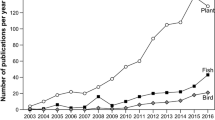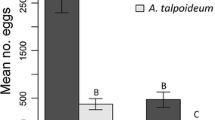Abstract
Through environmentally induced maternal effects females may fine-tune their offspring’s phenotype to the conditions offspring will encounter after birth. If juvenile and adult ecologies differ, the conditions mothers experienced as juveniles may better predict their offspring’s environment than the adult females’ conditions. Maternal effects induced by the environment experienced by females during their early ontogeny should evolve when three ecological conditions are met: (1) Adult ecology does not predict the postnatal environmental conditions of offspring; (2) Environmental conditions for juveniles are correlated across successive generations; and (3) Juveniles occasionally settle in conditions that differ from the juvenile habitat of their mothers. By combining size-structured population counts, ecological surveys and a genetic analysis of population structure we provide evidence that all three conditions hold for Simochromis pleurospilus, a cichlid fish in which mothers adjust offspring quality to their own juvenile ecology. In particular we show (1) that the spatial niches and the habitat quality differ between juveniles and adults, and we provide genetic evidence (2) that usually fish of successive generations grow up in similar habitats, and (3) that occasional dispersal in populations with a different habitat quality is likely to occur. As adults of many species cannot predict their offspring’s environment from ambient cues, life-stage specific maternal effects are likely to be common in animals. It will therefore be necessary to incorporate parental ontogeny in the study of parental effects when juveniles and adults inhabit different environments.



Similar content being viewed by others
References
Amarillo-Suarez AR, Fox CW (2006) Population differences in host use by a seed-beetle: local adaptation, phenotypic plasticity and maternal effects. Oecologia 150:247–258
Badyaev AV (2009) Evolutionary significance of phenotypic accommodation in novel environments: an empirical test of the Baldwin effect. Phil Trans R Soc B 364:1125–1141
Ballinger RE, Newlin ME, Newlin SJ (1977) Age-specific shift in diet of crevice spiny lizard, Sceloporus poinsetti in southwestern New Mexico. Am Midland Nat 97:482–484
Bashey F (2006) Cross-generational environmental effects and the evolution of offspring size in the Trinidadian guppy Poecilia reticulata. Evolution 60:348–361
Carlton KL, Streelman JT, Lee BY, Garnhart N, Kidd M, Kocher TD (2002) Rapid isolation of CA microsatellites from the tilapia genome. Anim Gen 33:140–144
Clark DB, Gibbons JW (1969) Dietary shift in turtle Pseudemys scripta (Schoepff) from youth to maturity. Copeia 704–708
Clarke A, Johnston NM (1999) Scaling of metabolic rate with body mass and temperature in teleost fish. J Anim Ecol 68:893–905
Davies RW, Wrona FJ, Linton L, Wilkialis J (1981) Interspecific and intraspecific analyses ofthe food niches of 2 sympatric species of eprobdellidae (Hirudinoidea) in Alberta, Canada. Oikos 37:105–111
Dionne M, Sainte-Marie B, Bourget E, Gilbert D (2003) Distribution and habitat selection of early benthic stages of snow crab Chionoecetes opilio. Mar Ecol Progr Ser 259:117–128
Excoffier L, Laval G (2005) An integrated software package for population genetics data analysis. Evol Bioinfo Online 1:47–50
Excoffier L, Smouse PE, Quattro JM (1992) Analysis of molecular variance inferred from metric distances among DNA haplotypes: application to human mitochondrial DNA restriction data. Genetics 131:479–491
Galloway LF, Etterson JR (2007) Transgenerational plasticity is adaptive in the wild. Science 318:1134–1136
Gerlach GJ, Atema J, Kingsford MJ, Black KP, Miller-Sims V (2007) Smelling home can prevent dispersal of reef fish larvae. Proc Natl Acad Sci USA 104:858–863
Gillanders BM, Able KW, Brown JA, Eggleston DB, Sheridan PF (2003) Evidence of connectivity between juvenile and adult habitats for mobile marine fauna: an important component of nurseries. Mar Ecol Progr Ser 247:281–295
Hamilton G, Currat M, Ray N, Heckel G, Beaumont M, Excoffier L (2005) Bayesian estimation of recent migration rates after a spatial expansion. Genetics 170:409–417
Heck KL, Hays G, Orth RJ (2003) Critical evaluation of the nursery role hypothesis for seagrass meadows. Mar Ecol Progr Ser 253:123–136
Heckel G, Burri R, Fink S, Desmet JF, Excoffier L (2005) Genetic structure and colonization processes in European populations of the common vole, Microtus arvalis. Evolution 59:2231–2242
Holm S (1979) A simple sequentially rejective multiple test procedure. Scand J Stat 6:65–70
Johannsson OE (1978) Coexistence of larval zygoptera (Odonata) common to Norfolk Broads UK. 1. Temporal and spatial separation. Oecologia 32:303–321
Jonsson N, Jonsson B, Fleming IA (1996) Does early growth cause a phenotypically plastic response in egg production of Atlantic Salmon? Funct Ecol 10:89–96
Kinnison MT, Unwin MJ, Hendry AP, Quinn TP (2001) Migratory costs and the evolution of egg size and number in introduced and indigenous salmon populations. Evolution 55:1656–1667
Kotrschal A (2010) The influence of early environment on later life - physiology, behaviour and evolution. Dissertation, University of Bern
Kotrschal A, Taborsky B (2010a) Resource defence or exploded lek—a question of perspective. Ethology 116:1–10
Kotrschal A, Taborsky B (2010b) Environmental change enhances cognitive abilities in fish. PLoS Biol 8:e1000351
Kotrschal A, Fischer B, Taborsky B (2011) A non-invasive method to determine fat content in small fish based on swim bladder size estimation. J Exp Zool 313A:1–6
Kramer DL, Manley D, Bourgeois R (1983) The Effect of respiratory mode and oxygen concentration on the risk of aerial predation in fishes. Can J Zool 61:653–665
Lacey EP, Mousseau TA, Fox CW (1998) What is an adaptive environmentally induced parental effect? In: Lacey EP, Mousseau TA, Fox CW (eds) Maternal effects ad adaptations. Oxford University Press, Oxford, pp 54–66
Lee WJ, Kocher TD (1995) Microsatellite DNA markers for genetic mapping in oreochromis niloticus. J Fish Biol 49:169–171
Leger DW, Didrichsons IA (1994) An assessment of data pooling and some alternatives. Anim Behav 48:823–832
Lind AJ, Welsh HH (1994) Onotogenetic changes in foraging bahavior and habitat use by the oregon garter snake, Thamnophis atratus hydrophilus. Anim Behav 48:1261–1273
Mousseau TA, Fox CW (1998) The adaptive significance of maternal effects. Trends Ecol Evol 13:403–407
Mumby PJ, Edwards AJ, Arias-Gonzalez JE, Lindeman KC, Blackwell PG, Gall A, Gorczynska MI, Harborne AR, Pescod CL, Renken H, Wabnitz CCC, Llewellyn G (2004) Mangroves enhance the biomass of coral reef fish communities in the Caribbean. Nature 427:533–536
Parker A, Kornfield I (1996) Polygynandry in Pseudotropheus zebra, a cichlid fish from Lake Malawi. Env Biol Fish 47:345–352
Pough FH (1973) Lizard energetics and diet. Ecology 54:837–844
Power ME (1984) Depth distributions of armored catfish—predator-induced resource avoidance. Ecology 65:523–528
Quinn TP (1993) A review of homing and straying of wild and hatchery-produced salmon. Fisher Res 18:29–44
Räsänen K, Kruuk LEB (2007) Maternal effects and evolution at ecological time-scales. Funct Ecol 21:408–421
Räsänen K, Soderman F, Laurila A, Merila J (2008) Geographic variation in maternal investment: acidity affects egg size and fecundity in Rana arvalis. Ecology 89:2553–2562
Rotem K, Agrawal AA, Kott L (2003) Parental effects in Pieris rapae in response to variation in food quality: adaptive plasticity across generations? Ecol Entom 28:211–218
Rousset F (1997) Genetic differentiation and estimation of gene flow from F-statistics under isolation by distance. Genetics 145:1219–1228
Ruiz GM, Hines AH, Posey MH (1993) Shallow-water as a refuge habitat for fish and crustaceans in nonvegetated estuaries—an example from Chesapeake Bay. Mar Ecol Progr Ser 99:1–16
Schliewen U, Rassmann K, Markmann M, Markert J, Kocher T, Tautz D (2009) Genetic and ecological divergence of a monophyletic cichlid species pair under fully sympatric conditions in Lake Ejagham, Cameroon. Mol Ecol 10:1471–1488
Schweizer M, Excoffier L, Heckel G (2007) Fine-scale genetic structure and dispersal patterns in the common vole Microtus arvalis Mol Ecol 16:2463–2473
Segers FHID, Taborsky B (2011) Egg size and food abundance interactively affect juvenile growth and behaviour. Funct Ecol 25:166–176
Segers FHID, Taborsky B (in revision) Fast growth of large offspring by effects of aggression in harsh environments. Behav Ecol
Smith MA, Green DM (2005) Dispersal and the metapopulation paradigm in amphibian ecology and conservation: are all amphibian populations metapopulations? Ecography 28:110–128
Smouse PE, Long JC, Sokal RR (1986) Multiple regression and extension of the mantel test of matrix correspondence. Syst Zool 35:627–632
Taborsky B (1999) Size-dependent distribution in littoral fish: optimization or competitive exclusion? In: Almada VC, Oliveira RF, Goncalves EJ (eds) Behaviour and conservation of littoral fishes. Lisboa, pp 351–376
Taborsky B (2006a) Mothers determine offspring size in response to own juvenile growth conditions. Biol Lett 2:225–228
Taborsky B (2006b) The influence of juvenile and adult environments on life-history trajectories. Proc R Soc B 273:741–750
Town JC (1981) Prey characteristics and dietary composition in intertidal Astrostole scabra (Echinodermata, Asteroidea). N Z J Mar Freshw Res 15:69–80
Turner M (1979) Diet and feeding phenology of the green lynx spider, Peucetia viridans (Araneae, Oxyopidae). J Arachn 7:149–154
Uller T (2008) Developmental plasticity and the evolution of parental effects. Trends Ecol Evol 23:432–438
Van Buskirk J, Arioli M (2005) Habitat specialization and adaptive phenotypic divergence of anuran populations. J Evol Biol 18:596–608
Van Oppen MJH, Rico C, Deutsch TC, Turner GF, Hewitt GM (1997) Isolation and characterization of microsatellite loci in the cichlid fish Pseudotropheus zebra. Mol Ecol 6:387–388
Wagner CE, McCune AR (2009) Contrasting patterns of spatial genetic structure in sympatric rock-dwelling cichlid fishes. Evolution 63:1312–1326
Weir BS, Cockerham CC (1984) Estimating F-statistics for the analysis of population structure. Evolution 38:1358–1370
Werner EE, Gilliam JF (1984) The ontogenetic niche and species interactions in size structured populations. Ann Rev Ecol Syst 15:393–425
Whitfield AK, Blaber SJM (1979) Feeding ecology of piscivorous birds at Lake St Lucia.2. Wading birds. Ostrich 50:1–9
Zardoya R, Vollmer DM, Craddock C, Streelman JT, Karl SA, Meyer A (1996) Evolutionary conservation of microsatellite flanking regions and their use in resolving the phylogeny of cichlid fishes (Pisces: Perciformes). Proc R Soc 263:1589–1598
Acknowledgments
We thank Martin Jiskra for help with the collection of field data, and Michael Taborsky, Catherine Wagner, Alex Hayward and two anonymous referees for comments on the manuscript, Dik Heg and Göran Arnqvist for help with statistics, Roger Schürch, Fardo Witsenburg, Oliver Otti and the Fisheries Department Mpulungu of the Ministry of Agriculture and Cooperatives, Zambia for logistic and scientific support in Zambia, and Evi Zwygart and Janne Schöning for logistic support in Europe. This study was funded by the Swiss National Science Foundation (grant 3100A0-111796 to B.T) and the Austrian Science Fund (FWF; grant P18647-B16 to B.T.).
Author information
Authors and Affiliations
Corresponding author
Electronic supplementary material
Below is the link to the electronic supplementary material.
Rights and permissions
About this article
Cite this article
Kotrschal, A., Heckel, G., Bonfils, D. et al. Life-stage specific environments in a cichlid fish: implications for inducible maternal effects. Evol Ecol 26, 123–137 (2012). https://doi.org/10.1007/s10682-011-9495-5
Received:
Accepted:
Published:
Issue Date:
DOI: https://doi.org/10.1007/s10682-011-9495-5




